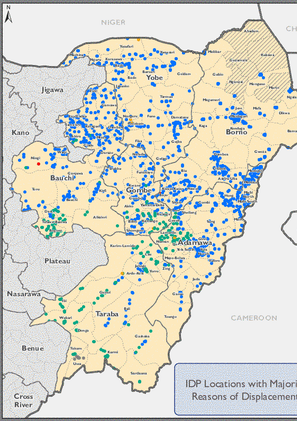-
Countries
-
Data and Analysis
-
Special Focus
-
Crisis Responses
Baseline Assessment

Contact
DTM Sudan; dtmsudan@iom.int
Language
English
Location
Sudan
Period Covered
Jul 17 2024
Jul 31 2024
Activity
- Mobility Tracking
- Baseline Assessment
This report reflects data corresponding to Sudan Mobility Update (3) dataset. The dataset is available here.
Overview:
This report provides an overview of the total population of internally displaced persons (IDPs) in Sudan, including those displaced both before and after the onset of the conflict on 15 April 2023.
Key Findings:
- An estimated total of 10,710,015 IDPs were displaced to 8,790 locations, in 183 localities, across all 18 states in Sudan.
- An estimated 7,914,235 individuals were displaced internally within Sudan since 15 April 2023.
- An estimated 27 per cent of IDPs who were initially displaced prior to the onset of the current conflict experienced secondary displacement since 15 April 2023.
- Approximately 2,312,968 individuals crossed borders into neighbouring countries since 15 April 2023.
- The top states of origin among IDPs were Khartoum (34%), South Darfur (19%), and North Darfur (14%).
- The states hosting the most IDPs were South Darfur (17%), North Darfur (14%) and Central Darfur (8%).
- Over half (52%) of IDPs were reportedly children under the age of 18-years-old.
Annex 1 includes an operational matrix with a table of estimated IDPs per state, disaggregated by displacement before versus after 15 April 2023.
Note: The number of IDPs displaced post 15 April 2023 (7,914,235 IDPs) includes the estimated 1,024,992 IDPs who were initially displaced prior to 15 April 2023 and experienced secondary displacement since 15 April 2023. DTM Sudan defines an internally displaced person as any person who has been forced or obliged to flee from their habitual residence due to an event dating from 2003 onwards.
Contact
DTM Iraq, IraqDTM@iom.int
Location
Iraq
Activity
- Mobility Tracking
- Baseline Assessment
Period Covered
Jan 01 2024 -Apr 30 2024
Since 2014, the International Organization for Migration’s (IOM) Displacement Tracking Matrix (DTM) unit in Iraq has collected information on internally displaced persons (IDPs) and returnees using a network of key informants across the country.1 Data for this round were collected from 1 January to 30 April 2024. For this current round, in contrast to prior ones, DTM excluded all the locations where the the key informant was not accessible; thus, some of the variations in the number of IDPs and returnees could be attributed to inability to obtain the most updated information.
• As of 30 April 2024, DTM identified 4,871,916 individual returnees (811,986 households).
• Increase of 8,844 individual returnees since previous round (+0.2%).
• The percentage increase in returnee individuals was smaller this round compared to the previous one (0.2% versus 0.4%).
Nonetheless, the highest increase was observed in Salah al-Din Governorate (4,308 individuals) and Ninewa Governorate (3,306 individuals).
Population Groups
Returnee (Previously Internally Displaced)
Survey Methodology
Unit of Analysis Or Observation
Admin Area 4
Individual
Type of Survey or Assessment
Key Informant
Keywords
Geographical Scope Partial Coverage
Administrative boundaries with available data
The current dataset covers the following administrative boundaries
Contact
DTM Iraq, IraqDTM@iom.int
Location
Iraq
Activity
- Mobility Tracking
- Baseline Assessment
Period Covered
Jan 01 2024 -Apr 30 2024
Since 2014, the International Organization for Migration’s (IOM) Displacement Tracking Matrix (DTM) unit in Iraq has collected information on internally displaced persons (IDPs) and returnees using a network of key informants across the country.1 Data for this round were collected from 1 January to 30 April 2024. For this current round, in contrast to prior ones, DTM excluded all the locations where the the key informant was not accessible; thus, some of the variations in the number of IDPs and returnees could be attributed to inability to obtain the most updated information.
• As of 30 April 2024, DTM identified 1,098,913 individual IDPs (188,390 households).
• Decrease of 24,750 individual IDPs since the previous round (-2.2%).
• The highest decrease in individual numbers was in the governorates of Ninewa (-10,004), followed by Sulaymaniyah (-3,987), Salah al-Din (-3,480), Erbil (-2,700) and Dahuk (-2,089).
Population Groups
IDPs
Survey Methodology
Unit of Analysis Or Observation
Admin Area 4
Individual
Type of Survey or Assessment
Key Informant
Keywords
Geographical Scope Full Coverage
Administrative boundaries with available data
The current dataset covers the following administrative boundaries
Returnee comparison at the Location level. Change in the number of returnees compared to Round 46.
Returnee comparison at the Local Government Area (LGA) level. Change in the number of returnees compared to Round 46.
Period of arrival of returnees who arrived from abroad.
Period of arrival of returnees who arrived from within Nigeria.
Returnees by LGA.
IDP reasons for displacement
IDP comparison at the Local Government Area (LGA) level. Change in the number of IDPs compared to Round 46.
Pagination
- Previous page
- Page 15
- Next page







